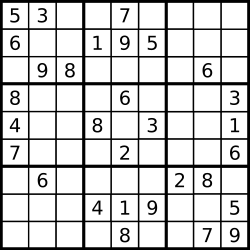Problem
Determine if a 9x9 Sudoku board is valid. Only the filled cells need to be validated according to the following rules:
- Each row must contain the digits
1-9without repetition. - Each column must contain the digits
1-9without repetition. - Each of the 9
3x3sub-boxes of the grid must contain the digits1-9without repetition.

A partially filled sudoku which is valid.
The Sudoku board could be partially filled, where empty cells are filled with the character '.'.
Example 1:
Input:
[
["5","3",".",".","7",".",".",".","."],
["6",".",".","1","9","5",".",".","."],
[".","9","8",".",".",".",".","6","."],
["8",".",".",".","6",".",".",".","3"],
["4",".",".","8",".","3",".",".","1"],
["7",".",".",".","2",".",".",".","6"],
[".","6",".",".",".",".","2","8","."],
[".",".",".","4","1","9",".",".","5"],
[".",".",".",".","8",".",".","7","9"]
]
Output: true
Example 2:
Input:
[
["8","3",".",".","7",".",".",".","."],
["6",".",".","1","9","5",".",".","."],
[".","9","8",".",".",".",".","6","."],
["8",".",".",".","6",".",".",".","3"],
["4",".",".","8",".","3",".",".","1"],
["7",".",".",".","2",".",".",".","6"],
[".","6",".",".",".",".","2","8","."],
[".",".",".","4","1","9",".",".","5"],
[".",".",".",".","8",".",".","7","9"]
]
Output: false
Explanation: Same as Example 1, except with the 5 in the top left corner being
modified to 8. Since there are two 8's in the top left 3x3 sub-box, it is invalid.
Note:
- A Sudoku board (partially filled) could be valid but is not necessarily solvable.
- Only the filled cells need to be validated according to the mentioned rules.
- The given board contain only digits
1-9and the character'.'. - The given board size is always
9x9.
Solution (Java)
class Solution {
public boolean isValidSudoku(char[][] board) {
int [] vset = new int [9];
int [] hset = new int [9];
int [] bckt = new int [9];
int idx = 0;
for (int i = 0; i < 9; i++) {
for (int j = 0; j < 9; j++) {
if (board[i][j] != '.') {
idx = 1 << (board[i][j] - '0') ;
if ((hset[i] & idx) > 0 ||
(vset[j] & idx) > 0 ||
(bckt[(i / 3) * 3 + j / 3] & idx) > 0) return false;
hset[i] |= idx;
vset[j] |= idx;
bckt[(i / 3) * 3 + j / 3] |= idx;
}
}
}
return true;
}
}
Solution (Javascript)
/**
* @param {character[][]} board
* @return {boolean}
*/
var isValidSudoku = function(board) {
var map = {};
var tmp = 0;
for (var i = 0; i < 9; i++) {
for (var j = 0; j < 9; j++) {
tmp = board[i][j];
if (tmp === '.') continue;
if (map['i' + i + tmp] || map['j' + j + tmp] || map['b' + Math.floor(i / 3) + Math.floor(j / 3) + tmp]) return false;
map['i' + i + tmp] = 1;
map['j' + j + tmp] = 1;
map['b' + Math.floor(i / 3) + Math.floor(j / 3) + tmp] = 1;
}
}
return true;
};
Explain:
哈希表:
i、j、b 开头的键分别代表 某行、某列、某块 中,某数字是否已存在
Complexity:
- Time complexity : O(n^2).
- Space complexity : O(n).